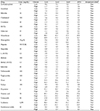| Korean J Health Promot > Volume 17(4); 2017 > Article |
|
ABSTRACT
Background
Methods
Results
REFERENCES
Figure┬Ā1
System accuracy plot and consensus error grid analysis of G300. The letter A means ŌĆśerror grid zone AŌĆÖ and the letter B means ŌĆśerror grid zone BŌĆÖ. Error grid analysis showed that all values (100%) are within zone A.

Figure┬Ā2
Interference of hematocrit. Interval 1 glucose concentration is 30ŌĆō50 mg/dL, interval 2 is 96ŌĆō144 mg/dL and interval 3 is 280ŌĆō420 mg/dL. Difference from hematocrit 40% was within ┬▒10 mg/dL in interval 1 and difference from hematocrit 40% was within ┬▒10% in interval 2 and 3.

Figure┬Ā4
System accuracy plot, consensus error grid analysis (CEG) and correlation between user and technician. The letter A means ŌĆśerror grid zone AŌĆÖ and the letter B means ŌĆśerror grid zone BŌĆÖ. Error grid analysis showed that all values (100%) are within zone A.

Table┬Ā1
Within-run precision of G300

Abbreviations: YSI, yellow springs instruments; SD, standard deviation; CV, coefficient of variation.
Acceptance criteria: <100 mg/dL: SD less than 5 mg/dL, Ōēź100 mg/dL: CV less than 5%. The numbers in the farthest left of the table represent 5 consecutive intervals of concentration levels (30ŌĆō50 mg/dL, 51ŌĆō110 mg/dL, 111ŌĆō150 mg/dL, 151ŌĆō250 mg/dL, 251ŌĆō400 mg/dL) to which blood glucose concentrations sampled from patients belong to.
Table┬Ā2
Day to day precision of G300

Abbreviations: Conc., concentration; SD, standard deviation; CV, coefficient of variation.
Acceptance criteria: <100 mg/dL: SD less than 5 mg/dL, Ōēź100 mg/dL: CV less than 5%. The intervals 1 to 3 represent 3 intervals of blood glucose concentrations (30ŌĆō50 mg/dL, 96ŌĆō144 mg/dL, 280ŌĆō420 mg/dL) and the numbers next to them are blood glucose concentrations of the samples of controls provided by the manufacturers accordingly to each intervals.
Table┬Ā4
Interference test of 24 possible interfering substances

Abbreviations: Conc., concentration; EDTA, ethylenediaminetetraacetic acid; L-DOPA, L-3, 4-dihydroxyphenylalanine; DOPA, dihydroxyphenylalanine.
Glucose low: 50ŌĆō100 mg/dL, high: 250ŌĆō350 mg/dL.
aEach result from Lot1, Lot2, Lot3, and AVG means average of difference from control sample 10 times repeated measurement. Acceptance criteria is that difference from control sample was within ┬▒10 mg/dL in low glucose interval (<100 mg/dL) and difference from control sample was within ┬▒10% in high glucose interval (Ōēź100 mg/dL).





 PDF Links
PDF Links PubReader
PubReader ePub Link
ePub Link Full text via DOI
Full text via DOI Download Citation
Download Citation Print
Print



